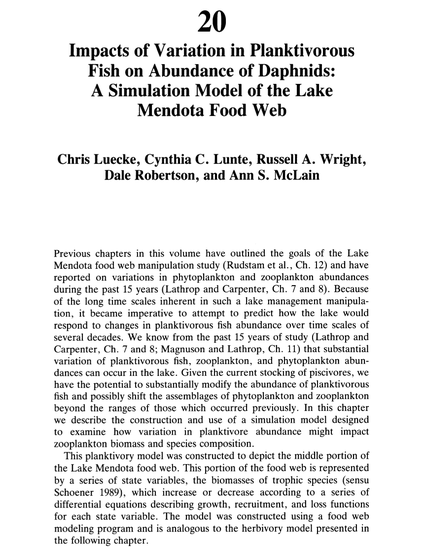
Contribution to Book
Impacts of variation in planktivorous fish on abundance of daphnids: a simulation model of thelake Mendota food web
Food Web Management: A Case Study of Lake Mendota
(1992)
Abstract
Previous chapters in this volume have outlined the goals of the Lake Mendota food web manipulation study (Rudstam et al., Ch. 12) and have reported on variations in phytoplankton and zooplankton abundances during the past 15 years (Lathrop and Carpenter, Ch. 7 and 8). Because of the long time scales inherent in such a lake management manipulation, it became imperative to attempt to predict how the lake would respond to changes in planktivorous fish abundance over time scales of several decades. We know from the past 15 years of study (Lathrop and Carpenter, Ch. 7 and 8; Magnuson and Lathrop, Ch. 11) that substantial variation of planktivorous fish, zooplankton, and phytoplankton abundances can occur the lake. Given the current stocking of piscivores, we have the potential to substantially modify the abundance of planktivorous fish and possibly shift the assemblages of phytoplankton and zooplankton beyond the ranges of those which occurred previously. In this chapter we describe the construction and use of a simulation model designed to examine how variation in plantivore abundance might impact zooplankton biomass and species composition.
Keywords
- planktivorous,
- fish,
- daphnids,
- food web
Disciplines
Publication Date
January 1, 1992
Editor
J.F. Kitchell
Publisher
Springer
Citation Information
Luecke, C. 1992. Impacts of variation in planktivorous fish on abundance of daphnids: a simulation model of the
lake Mendota food web: 418-426 In J.F. Kitchell, J.F. (ed.). Food Web Management: A Case Study of
Lake Mendota. Springer.
